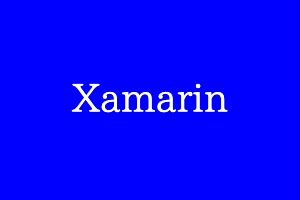Xamrin.Forms アラートダイアログ(DisplayAlert)のボタンの文字色の変え方を説明します。
1.共通プロジェクトに各OSのダイアログを呼び出すインターフェースを実装
public interface ICustomDisplayAlert {
Task<bool> DisplayAlert(string title, string message, string accept, string cancel);
}2.Androidプロジェクト内のResources>values>styles.xmlに文字色を定義する
<style name="CustomStyle" parent="Widget.AppCompat.Button.Borderless.Colored"/>
<style name="CustomStyle.Negative">
<item name="android:textColor">#0000ff</item>
</style>
<style name="CustomStyle.Positive">
<item name="android:textColor">#ff0000</item>
</style>
<style name="CustomDialogStyle" parent="Theme.AppCompat.Light.Dialog.Alert">
<item name="buttonBarNegativeButtonStyle">@style/CustomStyle.Negative</item>
<item name="buttonBarPositiveButtonStyle">@style/CustomStyle.Positive</item>
</style>3.Androidプロジェクト内 MainActivity.cs内にContextを外から参照できる変数を用意
public static Context context;
protected override void OnCreate(Bundle savedInstanceState) {
~
~
context = this;
}4.Androidプロジェクト内にダイアログを表示するクラスを追加
using Xamarin.Forms;
using System.Threading.Tasks;
using TestPrj;
using TestPrj.Droid;
[assembly: Dependency(typeof(CustomDisplayAlert))]
namespace TestPrj.Droid {
public class CustomDisplayAlert : ICustomDisplayAlert {
public CustomDisplayAlert() { }
public Task<bool> DisplayAlert(string title, string message, string accept, string cancel) {
var taskComplete = new TaskCompletionSource<bool>();
var alert = new Android.Support.V7.App.AlertDialog.Builder(MainActivity.context, global::TestPrj.Droid.Resource.Style.CustomDialogStyle);
alert.SetTitle(title);
alert.SetMessage(message);
alert.SetNegativeButton(cancel, (sender, e) => {
taskComplete.SetResult(false);
});
alert.SetPositiveButton(accept, (sender, e) => {
taskComplete.SetResult(true);
});
Device.BeginInvokeOnMainThread(() => alert.Create().Show());
return taskComplete.Task;
}
}
}5.iOSプロジェクト内にダイアログを表示するクラスを追加
using Xamarin.Forms;
using System.Threading.Tasks;
using UIKit;
using TestPrj;
using TestPrj.iOS;
using Foundation;
[assembly: Dependency(typeof(CustomDisplayAlert))]
namespace TestPrj.iOS {
public class CustomDisplayAlert : ICustomDisplayAlert {
public Task<bool> DisplayAlert(string title, string message, string accept, string cancel) {
var taskComplete = new TaskCompletionSource<bool>();
UIApplication.SharedApplication.InvokeOnMainThread(() => {
var alertController = UIAlertController.Create(title, message, UIAlertControllerStyle.Alert);
var acceptAction = UIAlertAction.Create(accept, UIAlertActionStyle.Default, x => {
taskComplete.SetResult(true);
});
acceptAction.SetValueForKey(UIColor.Green, new NSString("titleTextColor"));
alertController.AddAction(acceptAction);
var cancelAction = UIAlertAction.Create(cancel, UIAlertActionStyle.Cancel, x => {
taskComplete.SetResult(false);
});
cancelAction.SetValueForKey(UIColor.Orange, new NSString("titleTextColor"));
alertController.AddAction(cancelAction);
var controller = GetViewController();
controller.PresentViewController(alertController, true, null);
});
return taskComplete.Task;
}
UIViewController GetViewController() {
var rootViewController = UIApplication.SharedApplication.KeyWindow.RootViewController;
if (rootViewController.PresentedViewController == null)
return rootViewController;
if (rootViewController.PresentedViewController is UINavigationController)
return ((UINavigationController)rootViewController.PresentedViewController).VisibleViewController;
if (rootViewController.PresentedViewController is UITabBarController)
return ((UITabBarController)rootViewController.PresentedViewController).SelectedViewController;
return rootViewController.PresentedViewController;
}
}
}6.呼び出して使う
await DependencyService.Get<ICustomDisplayAlert>().DisplayAlert("title", "msg", "OK", "NO");
